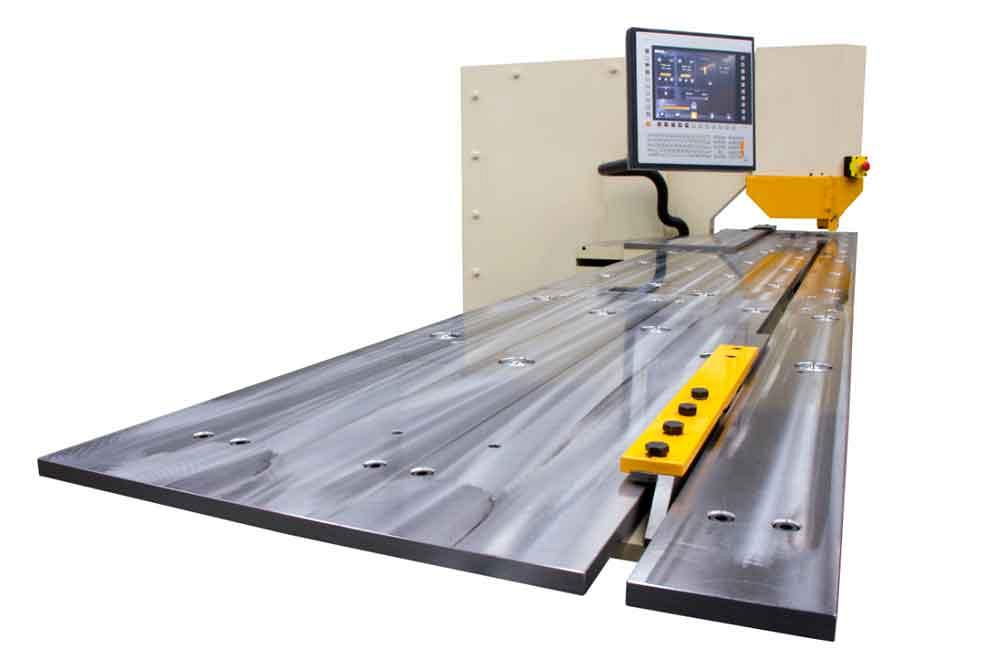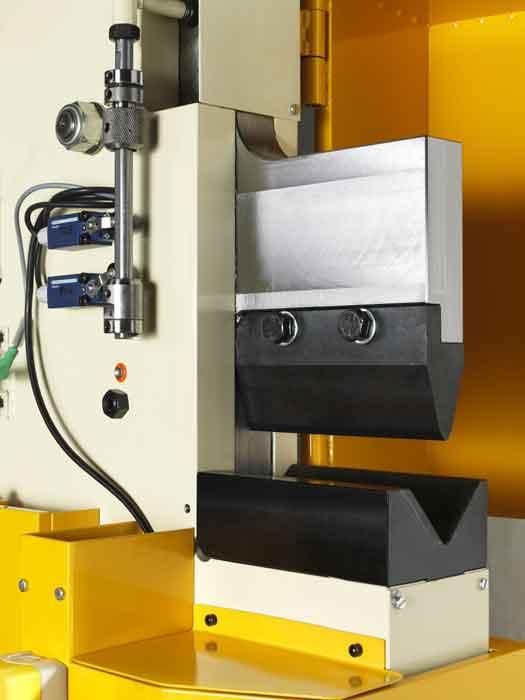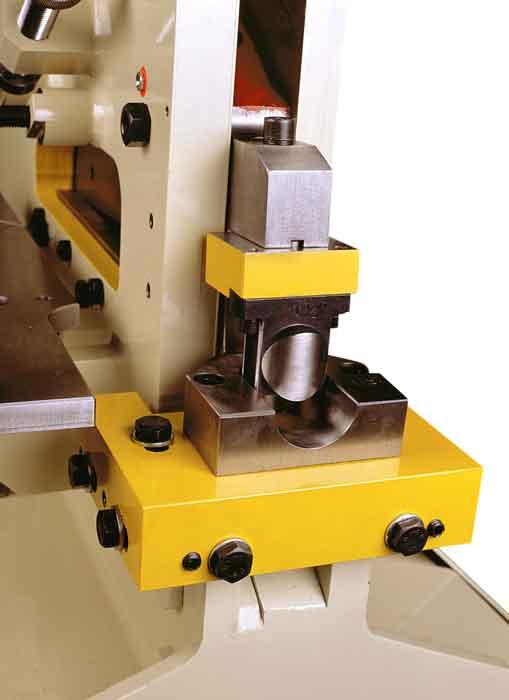Contributing Writer
- FMA
- The Fabricator
- FABTECH
- Canadian Metalworking
Categories
- Additive Manufacturing
- Aluminum Welding
- Arc Welding
- Assembly and Joining
- Automation and Robotics
- Bending and Forming
- Consumables
- Cutting and Weld Prep
- Electric Vehicles
- En Español
- Finishing
- Hydroforming
- Laser Cutting
- Laser Welding
- Machining
- Manufacturing Software
- Materials Handling
- Metals/Materials
- Oxyfuel Cutting
- Plasma Cutting
- Power Tools
- Punching and Other Holemaking
- Roll Forming
- Safety
- Sawing
- Shearing
- Shop Management
- Testing and Measuring
- Tube and Pipe Fabrication
- Tube and Pipe Production
- Waterjet Cutting
Industry Directory
Webcasts
Podcasts
FAB 40
Advertise
Subscribe
Account Login
Search
How the ironworker fits in modern fabrication
The metalworking industry’s humble workhorse machine helps fab shops boost part flow
- By Don Letourneau
- June 15, 2020
- Article
- Shearing

Depending on their size, CNC positioning tables allow ironworkers to handle everything from small parts to 20-ft.-long structural sections.
The Tools

A CNC positioning table effectively eliminates manual layout and increases accuracy to levels that you wouldn’t expect from an ironworker.

A bending station on the ironworker in some cases can help relieve capacity constraints in the press brake department.
The Ironworker With Automation
You might ask how a manually operated machine fits into the high-tech shop. First of all, some applications and tasks simply don’t fit into an automated process. Even if they do, the setup can exceed the manufacturing cost, especially for small batches. It’s safe to say that almost any shop using high-tech equipment can use an ironworker to reduce costs and optimize specific parts for production.That said, some operations might need more, and here’s where the ironworker with CNC automation can play a role, especially for boosting productivity in punching and shearing. For the punch station, CNC positioning systems use ball screws for accuracy. The positioning works in both the X and Y dimensions. The Y dimension will depend on the machine’s throat depth, but the X dimension can range from 40 in. to 20 ft., depending on a shop’s needs. This means you can punch small parts or flat bar along with structural profiles up to 20 ft. long. A CNC positioning table effectively eliminates manual layout and increases accuracy to levels that you wouldn’t expect from an ironworker. You can program at the machine CNC using modern touchscreen graphic controls, or you can download a CAD file or part program from the shop network.You can store programs, recall them, or execute them right away after programming. After you enter the hole position into the control, the guides move to the first hole position; you then place the material against the guides and punch the first hole. After the guides move to each subsequent location, you reposition the workpiece and punch each hole until completion. At the shearing station, a CNC shearing and feeding system can shear flat bar into programmed lengths and quantities. Using a rotary encoder to measure the workpiece, the system works with a DC variable-speed motor using hydraulic clamping with drive rollers.Programming the ironworker’s shear is simple by nature. But even here, modern technologies can make the entire process easier to integrate with fully automated production. But wherever you place the ironworker on the floor, you can still connect the ironworker to the shop computer network. Regardless of the setup, a modern CNC ironworker’s connectivity gives you full control of the production process. It also allows the ironworker manufacturer or certified service provider to connect remotely for monitoring and updating.About Flow
Ironworkers can help the flow in your shop. You don’t want to be setting up larger machines to do a small job that can be performed on an ironworker. You could be using your larger machines at capacity. This is where the ironworker can play a big role in bending operations, corner notching, pipe or tube notching, punching, and shearing—all in a small amount of floor space.For instance, imagine you have a customer with an urgent need for a small order involving several dozen cut, punched, and bent plates, plus a few small structural shapes. You could squeeze the piece on the burn table, route it through the press brake department, and run small structural shapes through the band saw. But this flow steals production capacity, especially in bending, where you end up setting up and using a single punch and die set on a large press brake.But what about the ironworker? You have the tools to cut the structural shapes and punch the required holes. And instead of squeezing a few simple pieces onto a nest on the burn table, you could utilize remnants and simply shear the parts. The ironworker punches cleanly, and the variable rake angle in the shear allows you to cut workpieces of different thicknesses efficiently, easily meeting edge-quality requirements for the job without deburring.Now imagine a job that calls for notching a tubular assembly. It’s a one-off job of several dozen parts—all small-diameter tubes that don’t require intricate cuts. Your shop happens to have a machine dedicated for notching tubing and pipe, but setup is time-consuming, and the notched workpieces require cleanup. Besides, that machine is tied up on another job. Could you simply cut the tube to length and take it to an ironworker with a tube notching station?An ironworker with an automatic positioning table could supplement your cutting capacity at the band saw, at least for certain parts. The punch station could eliminate the need for a separate setup at the drill press. The possibilities go on. As the Swiss army knife of the fab shop, the ironworker introduces a range of routing possibilities. Take a good look at the flow in your shop and see how well the ironworker can eliminate many of the bottlenecks you now encounter.About the Author
Don Letourneau
P.O. Box 207
White Marsh, MD 21162
410-933-8500
Related Companies
subscribe now

The Fabricator is North America's leading magazine for the metal forming and fabricating industry. The magazine delivers the news, technical articles, and case histories that enable fabricators to do their jobs more efficiently. The Fabricator has served the industry since 1970.
start your free subscription- Stay connected from anywhere

Easily access valuable industry resources now with full access to the digital edition of The Fabricator.

Easily access valuable industry resources now with full access to the digital edition of The Welder.

Easily access valuable industry resources now with full access to the digital edition of The Tube and Pipe Journal.
- Podcasting
- Podcast:
- The Fabricator Podcast
- Published:
- 04/16/2024
- Running Time:
- 63:29
In this episode of The Fabricator Podcast, Caleb Chamberlain, co-founder and CEO of OSH Cut, discusses his company’s...
- Trending Articles
AI, machine learning, and the future of metal fabrication

Employee ownership: The best way to ensure engagement

Steel industry reacts to Nucor’s new weekly published HRC price

Dynamic Metal blossoms with each passing year

Metal fabrication management: A guide for new supervisors

- Industry Events
16th Annual Safety Conference
- April 30 - May 1, 2024
- Elgin,
Pipe and Tube Conference
- May 21 - 22, 2024
- Omaha, NE
World-Class Roll Forming Workshop
- June 5 - 6, 2024
- Louisville, KY
Advanced Laser Application Workshop
- June 25 - 27, 2024
- Novi, MI





























